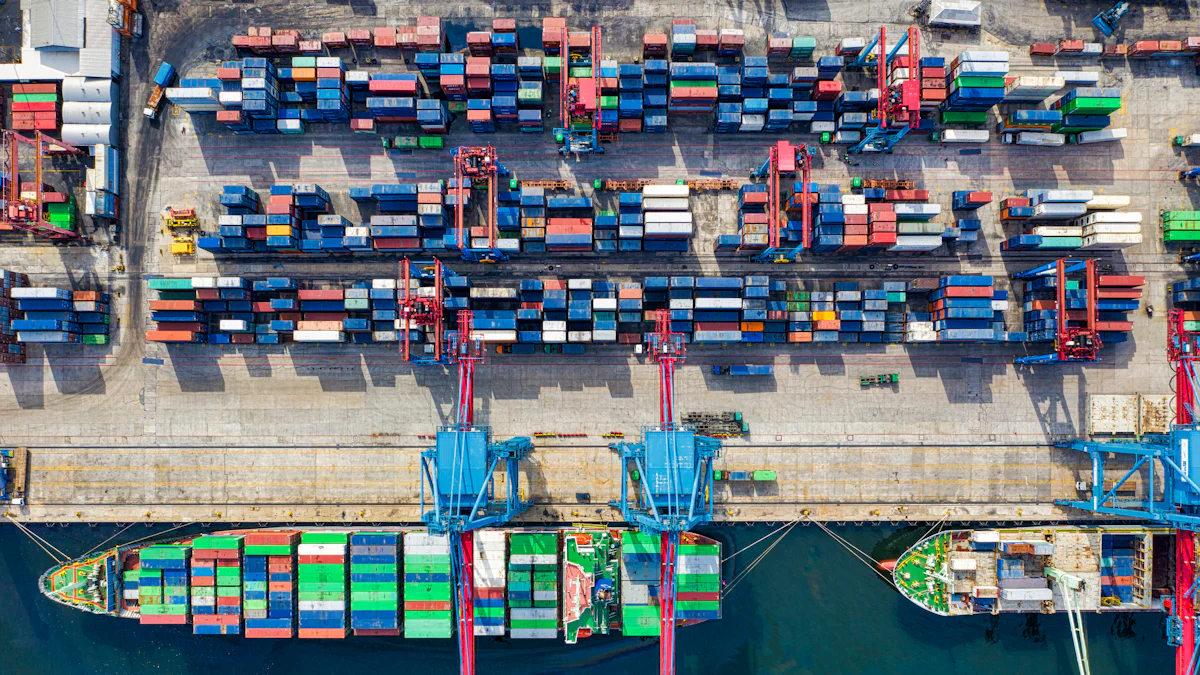Harnessing Data Analysis for Logistics Efficiency

Data analysis transforms logistics by enhancing efficiency and decision-making. Companies optimize transportation routes and reduce inventory levels through data insights. Real-time tracking of goods offers greater supply chain visibility. Logistics firms improve processes, cut costs, and boost customer satisfaction with data-driven strategies. AI in logistics reduces last-mile delivery costs by 14% and increases goods delivered per vehicle by 13%. Data analysis empowers businesses to meet customer demands and adapt to market trends effectively. Embracing data analytics ensures streamlined operations and competitive advantage.
Understanding Data Analysis in Logistics
Definition and Scope
What is Data Analysis?
Data analysis involves examining and interpreting data to extract valuable insights. This process transforms raw data into meaningful information. Businesses use data analysis to make informed decisions. The logistics industry relies on data analysis to enhance operations and efficiency.
Scope of Data Analysis in Logistics
Data analysis in logistics covers various aspects. Companies use it for route optimization, inventory management, and demand forecasting. Data analysis improves decision-making and enhances customer satisfaction. Logistics firms also integrate data analysis with emerging technologies like IoT and AI. This integration enables real-time decision-making and predictive maintenance.
Key Components
Data Collection
Data collection forms the foundation of data analysis. Logistics companies gather data from multiple sources. These sources include GPS systems, sensors, and customer feedback. Accurate data collection ensures reliable analysis. Companies must prioritize data accuracy and completeness.
Data Processing
Data processing involves cleaning and organizing collected data. This step prepares data for analysis. Companies use software tools to process large data sets efficiently. Proper data processing eliminates errors and inconsistencies. This step ensures that analysis results are accurate and reliable.
Data Interpretation
Data interpretation involves analyzing processed data to draw conclusions. Companies identify patterns and trends through interpretation. This step informs strategic decisions in logistics operations. Effective data interpretation leads to optimized routes and improved inventory management. Companies gain a competitive edge by making data-driven decisions.
Roles of Data Analysis in Enhancing Logistics Efficiency

Streamlining Operations
Route Optimization
Data analysis plays a crucial role in optimizing transportation routes for logistics companies. Companies analyze data to identify the most efficient paths for delivery vehicles. This optimization reduces fuel costs and emissions. Improved delivery times result from well-planned routes. Logistics companies enhance their performance by using data-driven insights. The strategic use of data analysis leads to cost savings and environmental benefits.
Inventory Management
Inventory management becomes more effective with data analysis. Companies monitor stock levels and predict demand accurately. This approach minimizes overstocking and stockouts. Businesses maintain optimal inventory levels by analyzing sales data and trends. Efficient inventory management reduces storage costs and improves cash flow. Data analysis empowers companies to make informed decisions about inventory replenishment.
Predictive Analytics
Demand Forecasting
Predictive analytics enables companies to forecast demand accurately. Businesses analyze historical sales data to anticipate future trends. Accurate demand forecasting helps companies align production with market needs. Companies avoid overproduction and underproduction by understanding customer demand patterns. Data analysis supports strategic planning and resource allocation. Businesses gain a competitive advantage through precise demand forecasting.
Risk Management
Risk management benefits significantly from data analysis. Companies identify potential risks and develop mitigation strategies. Data analysis provides insights into supply chain vulnerabilities. Businesses prepare for disruptions by analyzing risk factors. Effective risk management ensures smooth operations and customer satisfaction. Companies enhance their resilience by using data-driven risk assessments.
Benefits of Data Analysis in Logistics
Data analysis offers significant benefits in logistics. Companies can achieve cost reduction and improved customer satisfaction through effective data utilization.
Cost Reduction
Minimizing Waste
Data analysis helps logistics companies minimize waste. Businesses can identify inefficiencies in operations by analyzing data. This insight allows for the elimination of unnecessary processes. Companies can reduce excess inventory and optimize resource use. The result is a leaner, more efficient operation.
Efficient Resource Allocation
Efficient resource allocation becomes possible with data analysis. Companies can allocate resources based on accurate demand forecasts. This ensures that resources are used where they are most needed. Businesses can avoid overproduction and underutilization. Proper resource allocation leads to cost savings and increased productivity.
Improved Customer Satisfaction
Faster Delivery Times
Faster delivery times enhance customer satisfaction. Data analysis enables companies to optimize delivery routes. Businesses can ensure timely deliveries by analyzing traffic patterns and demand. Customers receive their products quickly, leading to higher satisfaction levels.
Enhanced Service Quality
Enhanced service quality results from data analysis. Companies can monitor service performance and identify areas for improvement. Data-driven insights allow businesses to address customer concerns promptly. Improved service quality fosters customer loyalty and trust.
Survey Results:
Data analytics has helped logistics companies optimize transportation routes.
Companies have reduced costs and improved customer service.
Businesses have seen an increase in revenue through data-driven strategies.
JUSDA's Data-Driven Approach
JusLink Platform
Full-Chain Visibility
The JusLink Platform offers full-chain visibility for supply chain management. Businesses gain real-time insights into every stage of the supply chain. This visibility allows companies to monitor operations from raw material procurement to final delivery. Companies can track goods and manage inventory effectively. The platform enhances transparency and control over logistics processes. Businesses can identify bottlenecks and optimize operations.
AI-Driven Insights
AI-driven insights power the JusLink Platform. Companies use artificial intelligence to analyze vast amounts of data. AI identifies patterns and trends that humans might miss. Businesses make informed decisions based on these insights. AI helps in predicting demand and optimizing routes. Companies reduce costs and improve efficiency with AI-driven strategies. The platform supports proactive decision-making and risk management.
Real-Time Monitoring and Risk Prevention
Advanced Analytics
Advanced analytics play a crucial role in real-time monitoring. Companies use analytics to assess the performance of their supply chains. Analytics provide insights into areas that need improvement. Businesses can predict potential disruptions and take preventive measures. Advanced analytics help in maintaining smooth operations. Companies enhance their competitiveness by using data-driven insights.
Integrated System Solutions
Integrated system solutions streamline logistics processes. The platform connects suppliers, manufacturers, and customers on a single interface. This integration fosters collaboration and efficient resource utilization. Companies benefit from seamless communication and information sharing. The platform supports comprehensive supply chain management. Businesses achieve better operational outcomes through integrated solutions. The system empowers companies to respond quickly to market changes.
Challenges in Implementing Data Analysis
Data analysis offers numerous benefits for logistics. However, challenges can arise during implementation. Understanding these challenges helps in overcoming them effectively.
Data Quality Issues
Inaccurate Data
Inaccurate data poses a significant challenge in data analysis. Logistics companies rely on precise data for decision-making. Errors in data lead to incorrect conclusions and poor decisions. Ensuring data accuracy is crucial for effective analysis. Companies need robust systems to verify and validate data before use.
Data Silos
Data silos occur when information is isolated within departments. This separation hinders comprehensive data analysis. Logistics firms require integrated systems for seamless data flow. Breaking down silos enhances collaboration and data sharing. Unified data access enables more accurate analysis and better decision-making.
Technological Barriers
Integration with Existing Systems
Integrating data analysis tools with existing systems presents a challenge. Many logistics companies have legacy systems in place. These systems may not support modern data analysis tools. Companies must invest in compatible technologies. Proper integration ensures smooth data flow and analysis.
High Implementation Costs
High costs deter some companies from adopting data analysis. Investment in technology and training requires substantial resources. Smaller firms may struggle with these expenses. However, the long-term benefits often outweigh the initial costs. Companies should consider data analysis as a strategic investment.
Transmetrics emphasizes the importance of data quality. Clean and qualified data is essential for machine learning algorithms. Effective digital technology relies on accurate data. Logistics companies must prioritize data quality for successful implementation.
Future Implications and Trends

Emerging Technologies
AI and Machine Learning
AI and machine learning transform logistics operations. Businesses use these technologies to predict future sales trends. Accurate demand forecasting ensures the right inventory levels. Companies avoid stockouts and overproduction. AI-driven insights improve decision-making in logistics processes. Data analysis empowers businesses to optimize routes and reduce costs. Automated systems enhance delivery efficiency and safety. The integration of AI with data analysis leads to smarter logistics operations.
Internet of Things (IoT)
The Internet of Things (IoT) revolutionizes supply chain management. IoT devices collect real-time data from various sources. Businesses gain insights into shipment tracking and inventory levels. Data analysis paired with IoT enables proactive risk management. Companies identify potential disruptions before they occur. IoT improves transparency and control over logistics operations. Enhanced visibility leads to better customer service and satisfaction. The combination of IoT and data analysis streamlines logistics processes.
Evolving Business Models
Real-time Analytics
Real-time analytics transform business models in logistics. Companies access up-to-the-minute data for decision-making. Data analysis provides insights into market trends and customer demands. Businesses adapt quickly to changes in the market. Real-time data helps optimize resource allocation. Companies achieve greater efficiency and productivity. The use of real-time analytics enhances competitiveness in the logistics industry.
Sustainable Logistics Practices
Sustainable logistics practices gain importance in modern business models. Companies focus on reducing environmental impact. Data analysis plays a crucial role in achieving sustainability goals. Businesses analyze data to minimize waste and optimize resource use. Efficient logistics operations lead to lower emissions and energy consumption. Sustainable practices improve brand reputation and customer loyalty. Data analysis supports the transition to greener logistics solutions.
Data analysis revolutionizes logistics by refining supply chains and predicting demand. Logistics companies can fine-tune inventory management and orchestrate efficient route planning. Data analytics slashes costs intelligently and orchestrates seamless shipment tracking. Businesses elevate customer satisfaction through informed decision-making. The future of logistics efficiency relies on data-driven strategies. Companies must adopt these strategies to remain competitive. Embracing data analytics ensures streamlined operations and operational excellence.
See Also
Revolutionizing Warehouse Efficiency with Logistics Robotics
Decoding Logistics Innovation: The AI Advantage
Redefining Efficiency: JUSDA's Logistics Optimization
Unlocking Supply Chain Efficiency: Logistics Savings Revealed
Transforming Supply Chain Management: Harnessing Big Data and AI
